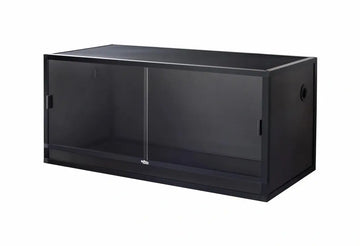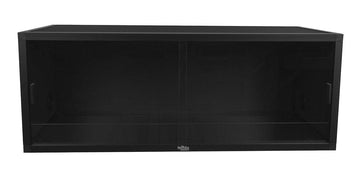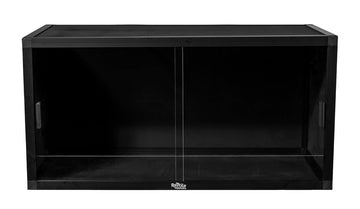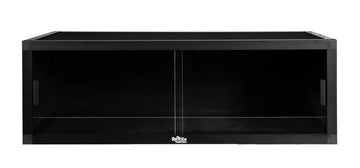Bearded dragons have exploded in popularity as an exotic pet to keep, especially in recent years they have become extremely popular, is relatively easy to keep and care for compared to other exotic pets, along with their easy-going nature it is easy to see why. But as with any exotic pet they do have very specific dietary needs. So what does a bearded dragon need to eat? See the following for an overview of the basics you need to know about what to feed a bearded dragon:
Bearded Dragon Diet
Bearded dragons are omnivores which means they need to eat both animals and plants to stay healthy. The age of the bearded dragon will determine the ratio of how much vegetation they need compared to how much protein they need.
A baby dragon (0-5 months) needs roughly 80% of their diet to be insect protein and 20% of their diet to be plant protein, the same can also be said for juveniles (5-18 months), this is due to the fact that the dragon is still growing and needs to absorb protein to fuel it's growth. Even though younger dragons have this requirement they won't always adhere to this automatically and it can be hard to get them to eat their fruits and vegetables, it is still necessary to at least offer them the chance even if they refuse, gut-loading your bugs with vegetables your dragon can eat will also help them to at least ingest some that way.
As a bearded dragon grows and becomes an adult (5-18 months) their diet changes to need the complete opposite ratio of 80% vegetables to 20% protein, as the priority has now changed from needing insect proteins for growth, to needing nutrients, vitamins, and minerals to maintain the dragon's health and wellbeing. The same goes for adults when it comes to changing the ratios of food they need, an adult may not change the diet up themselves, so it will be up to you to provide the correct ratios by withholding bugs and offering more salad than they are used to as babies and juveniles, being as all dragons love to eat live bugs, they may not be very happy with this arrangement.
What Insects Should A Bearded Dragon Be Eating?
The quick movements of live feeders mean that all dragons love to eat live feeder insects, they love anything that wriggles, crawls by or scuttles around, the movements catch their eye and they have a natural instinct to snap them up. This means that it is up to you to ensure that anything on offer to your dragon meets their dietary needs, read below to see our list of commonly found feeders insects for bearded dragons:
- Dubia Roaches
- Hornworms
- Waxworms
- Black Soldier Fly Larvae (Nutrigrubs)
- Butterworms
- Crickets
- Superworms
- Mealworms
- Other Roaches (Discoid, Turkestan, orange head)
- Earthworms
- King worms
- Silkworms
You should always avoid feeding your dragon any wild-caught insects, as these may have been exposed to pesticides, anything wild-caught is also known to have a higher risk to pass on parasites to your dragon or have a disease that could infect your dragon. Whether you have caught these inside your house or from somewhere outside they still carry the same risks.
Should I Buy Dubia Roaches Or Crickets?
Two of the most common feeder insects you will find for bearded dragons are dubia roaches and crickets. They can both offer a decent amount of nutrition, although per insect dubia roaches offer more, however, there are pro's and con's to also take into account when it comes to making the choice. The following is a comprehensive list of pro's and con's that should make the choice between the two easier to decide:
Dubia Pro's
- Are very quiet
- Cannot jump
- Cannot climb smooth surfaces
- Rarely escape
- Have little to no smell
- Have a very long lifespan
- Very clean so don't carry parasites (when purchased from a reputable vendor)
- Breed like rabbits
- Very resilient and hard to kill
- Easy to keep and care for
- Have double the protein and nutrients per insect
Cricket Pro's
- They aren't called roaches (people can get creeped out by the word roach)
- Easy to keep
Dubia Con's
- They stand still (you may have to nudge them to get them to move so a dragon will spot them)
- They are called roaches (people get creeped out by this but they do not resemble the household roach so it is easy to get used to)
Cricket Con's
- They are very noisy!
- They jump around when trying to feed your dragon making them hard to catch for your dragon
- They jump out when you open the lid to their container
- They smell bad
- Difficult to breed
- Die easily
- Are dirty and known to carry parasites
- Have half as much protein and nutrition per insect
Conclusion
While both crickets and dubia can technically both provide your dragon with nutrition that they need to keep your dragon healthy, the fact that there are quite a few more con's when it comes to crickets compared to dubia roaches, especially the facts that you get more nutrition and protein per insect with dubia and the fact that crickets are known to be dirtier and have a higher parasite infection risk compared to dubia, we would definitely recommend dubia roaches over crickets. One thing you will learn about dragons when you keep them is that they do have their own favorites, some dragons will prefer roaches over crickets and sometimes even vice versa. However, this can be a case of just what they are used to, so even if this seems to be the case it is important to give them an adequate chance to try dubia even if they don't seem to like them at first.
What Vegetables Should Bearded Dragons Eat?
Insects are a necessary part of your dragon's diet, but vegetables are another important aspect of their diet, It can often be confusing with all the various options available when it comes to vegetables for your dragon. There are vegetables that they cannot have, for various reasons some are just not safe for them to eat. The following is a list of vegetables that are safe for your dragon to eat:
- Acorn squash
- Alfalfa Sprouts
- Artichoke Heart
- Arugula
- Asparagus (Raw)
- Basil
- Bell Peppers (Raw)
- Bok choy
- Butternut squash
- Cabbage (Raw)
- Carrots
- Celery
- Chicory
- Cilantro
- Clover
- Collard greens
- Cucumber (Peeled)
- Endive
- Escarole
- Hibiscus (Flowers)
- Hibiscus (Leaves)
- Kale
- Kohlrabi
- Leeks
- Lemon Grass
- Lentils (Cooked)
- Mustard greens
- Nasturtiums
- Okra (Raw)
- Parsnips
- Peas
- Pea Sprouts
- Peppermint
- Pumpkins
- Radish
- Rosemary
- Radicchio
- Seaweed (Kelp)
- Spaghetti squash
- Turnip greens
- Watercress
- Winter Squash
- Wheatgrass
- Yams (Raw)
- Zucchini (Raw)
- Yellow squash
What Fruits Should A Bearded Dragon Eat?
As well as insects and vegetables, fruit is another option available for your dragon to eat, the bright colors and sweet smells can often entice them to eat a salad that they may not have done so otherwise, however fruit is high in moisture and sugar generally so should only be fed as a small part of their salad; fruit should only make up around a fifth of their daily salad. Read the following for a list of safe fruits that your bearded dragon can eat:
- Apples
- Apricot
- Blackberries
- Blueberries
- Cantaloupe
- Chayote
- Cranberries
- Figs
- Grapes
- Guava
- Mangos
- Melons
- Nectarines
- Papayas
- Peaches
- Pears
- Plums
- Prunes
- Raisins (seedless)
- Raspberries
- Strawberries
- Watermelon
There are certain types of fruits you may have noticed that aren't included on the list, citrus fruits are one of the main types of fruit that it is important to avoid when it comes to dragons, the high level of acidity can hurt your dragon's stomach and should be avoided. We have tried to make this list as comprehensive as possible but there will be fruits that aren't on the list, if you're ever unsure about something be sure to do thorough research before feeding something to your dragon that you aren't sure about.











